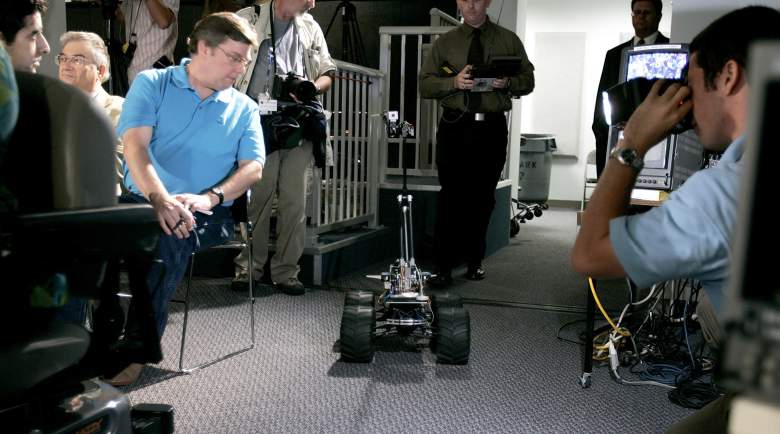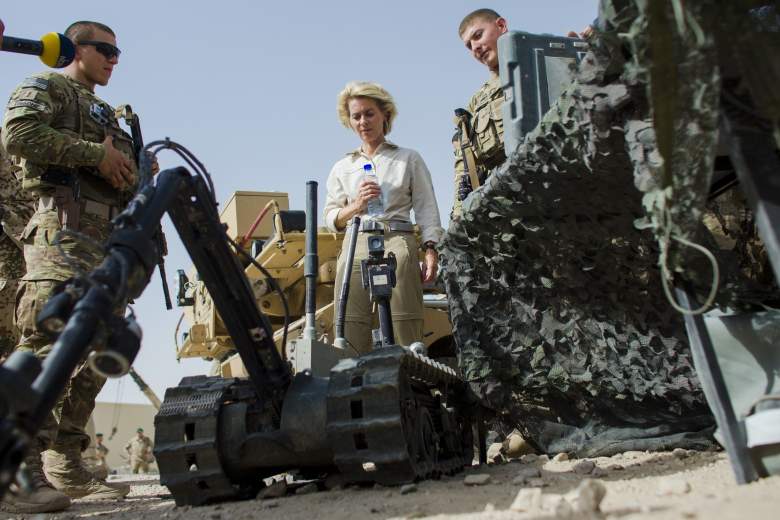
A technician from the United States Army Rapid Equipping Force (REF) steers the Multi-Function Agile Remote-Controlled Robot (MARCBOT), a small robot on four wheels that has a video camera lens for eyes, into a press conference in 2005. It’s not yet clear what robot was used by the Dallas police, but it’s been indicated that it too is likely to be a MARCbot. (Getty)
Five police officers were killed and several others were injured last night by sniper Micah Xavier Johnson at a Black Lives Matter protest in Dallas, Texas.
Police used a “bomb robot” early Friday to kill Johnson officials said.
“We cornered one suspect and we tried to negotiate for several hours,” Dallas Police Chief David Brown said during a Friday morning news conference, but “negotiations broke down” and turned into “an exchange of gunfire with the suspect.”
Some robotics experts say Dallas police appear to be the first law enforcement agency to use a robot to kill.
Here is more information about the circumstances of the situation, how the robot was utilized, and the questions it has raised over robotic force in the future.
Dallas Police Chief David Brown Said They Saw ‘No Other Option’
Brown told reporters that after hours of failed negotiations and in order to not put any more officers in danger, his department used a robot to deliver a bomb that killed the suspect.
Brown said a hostage negotiator spoke with the gunman at length before he was killed about 2:30 a.m. He said they saw no other option.
Similar Robots Have Reportedly Been Used by U.S. Soldiers in Iraq
Peter W. Singer, of the New America Foundation, a non-partisan think tank in the United States, says the killing of the suspect following Thursday night’s fatal shooting of five police officers is the first instance of which he’s aware of a robot being used lethally by police on U.S. soil.
Singer writes about the technology of warfare and is considered one of the world’s leading experts on 21st century security issues.
Kelsey Atherton, a writer for Popular Science who specializes in defense technology, also tweeted that this was a first for U.S. law enforcement.
Until now, robots have been used as a weapon only by the military.
According to the Associated Press, Singer wrote in an email Friday that when he was conducting research for his 2009 book Wired for War, a U.S. soldier told him troops in Iraq sometimes used MARCbot surveillance robots against insurgents.
It’s not yet clear what robot was used by the Dallas police, but it’s been indicated that it too is likely to be a MARCbot.
In the book The Changing Character of War, Singer describes how these robots have been used in Iraq.
The MARCbot is not just notable for its small size; it was the first ground robot to draw blood in Iraq. One unit of US soldiers jury-rigged their MARCbots to carry Claymore anti-personnel mines. If they thought an insurgent was hiding in an alley, they would send a MARCbot down first, and if they found someone waiting in ambush, take him out with the Claymore. Of course, each insurgent killed in this fashion meant $5,000 worth of blown-up robot parts, but so far the army has not billed the soldiers.
Bomb Robots Are Not Autonomous

German Defense Minister Ursula von der Leyen looks at a US radio controlled bomb disposal robot during a demonstration of ground equipment of various ISAF forces at Camp Marmal outside Mazar-i-Sharif on July 23, 2014. (Getty)
The MARCbot, as Singer described, “is like a toy truck with a sensor and camera mount they’d use to drive up to a checkpoint.” It is important to note that these types of robots are not autonomous, they are dependent on human decisions and human controllers.
They are controlled remotely, and used for tasks such as surveillance and investigating suspect bombs. Some are equipped with two way intercoms and cameras to allow for police to negotiate with suspects without as much risk.
For instance, in 2013, a SWAT team in Albuquerque used a robot to remove the blanket from a suicidal individual barricaded in his room, they did this to check whether or not he was armed. No weapon was seen and the SWAT team was able to safely take him into custody.
In other cases, when these robots are deployed for bomb disposal, they often use small explosives in order to trigger the larger bomb.
It Has Raised Concerns About The Use of Deadly Force by Law Enforcement
The events that transpired on Friday have raised practical and ethical questions regarding the government’s use of technology to exert lethal force at a distance.
“The military has over 12,000 robotic systems today — and police all over the place use robots for bomb disposal and surveillance,” Singer told The Post.
Elizabeth Joh, a law professor at the University of California at Davis said she was worried that the decision by police to use robots to end lives had been arrived at “far too casually.”
Like Singer and Atherton, Joh told The Guardian “it appears to be the first intentional use of a lethally armed robot by the police in the United States.”
She also emphasized the need to develop regulations for the use of robotic weapons in the future.
Joh told The Guardian:
Lethally armed police robots raise all sorts of new legal, ethical, and technical questions we haven’t decided upon in any systematic way,” she said. “Under federal constitutional law, excessive-force claims against the police are governed by the fourth amendment. But we typically examine deadly force by the police in terms of an immediate threat to the officer or others. It’s not clear how we should apply that if the threat is to a robot – and the police may be far away. In other words, I don’t think we have a framework for deciding objectively reasonable robotic force. And we need to develop regulations and policies now, because this surely won’t be the last instance we see police robots.